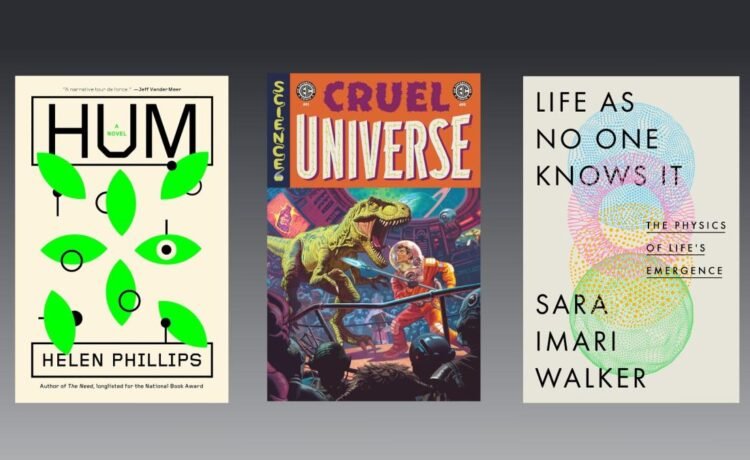New releases in fiction, nonfiction and comics that caught our attention.
Hum by Helen Phillips
Robots have become a regular fixture of the workforce, and humans are losing their jobs to AI. Climate change is wreaking havoc on the planet. It’s getting harder and harder for the average person to make ends meet. Facial recognition technology is being used for surveillance. Sound familiar? In her new novel, , author Helen Phillips paints a picture of what our near-future could look like.
Its main character, May, has lost her job after technology made her role obsolete, and, desperate for money to support her family, she agrees to participate in an experiment that alters her face to make her undetectable to facial recognition. With the extra cushion from the payment, she takes her husband and children on a short, technology-free vacation to the Botanical Garden — but things go dangerously awry. Hum is a captivating, unsettling work of dystopian fiction that makes it impossible not to draw parallels with our current reality.
Life as No One Knows It: The Physics of Life’s Emergence by Sara Imari Walker
There’s so much we don’t know about the origins of life on Earth, and how it could appear on other worlds. Arizona State University theoretical physicist and astrobiologist Sara Imari Walker tackles the enduring question, “What is life?” and so much more in her book, Life as No One Knows It: The Physics of Life’s Emergence. It explores assembly theory, which, as Walker explained recently as a guest on the podcast, states that “life is the only mechanism the universe has for generating complexity. So complex objects don’t happen spontaneously, they only happen through evolution and selection.”
It’s an endlessly fascinating topic that’s spurred a lot of debate over the years, and Walker’s book presents its case in a way that is compelling and readable even for us non-scientists. It’ll definitely give your brain a bit of exercise, though… and maybe spark some (friendly) arguments. called it, “Ingenious, but not for the faint of heart.
Cruel Universe #1
EC Comics’ comeback continues with the release of another new series, Cruel Universe. The recently resurrected publisher dropped the first issue of the science fiction series this week, featuring stories by Corinna Bechko, Chris Condon, Matt Kindt and Ben H. Winters, with art by Jonathan Case, Kano, Artyom Topilin and Caitlin Yarsky. takes us to an interstellar battle arena, face-to-face with a black hole, on a quest for eternal life and more.
It’s a great followup to , the new horror anthology from EC. If you liked the old Weird Science comics and EC’s other science fiction series, this is definitely one to check out.
This article contains affiliate links; if you click such a link and make a purchase, we may earn a commission.















